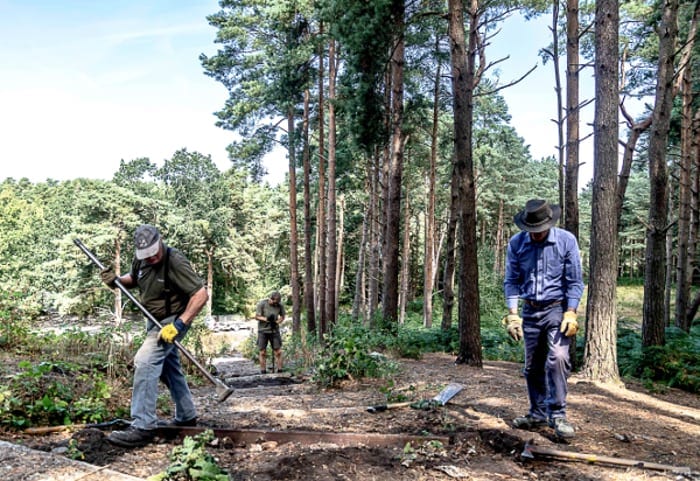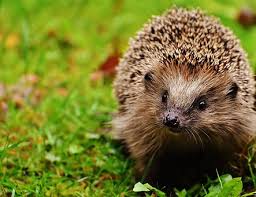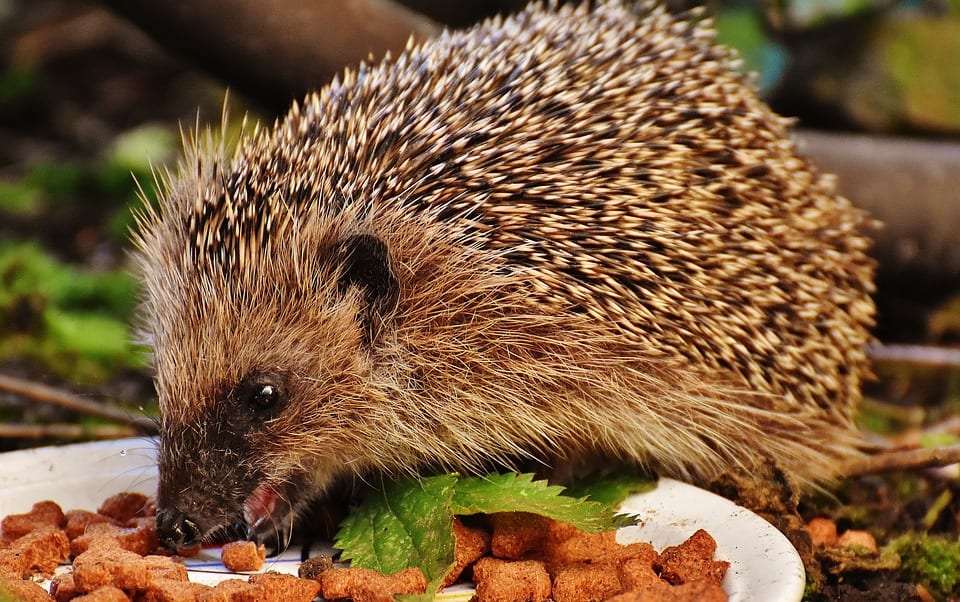We have been sent this photograph of the National Trust and its volunteers repairing the 39 Steps.
The timber used was chestnut coppiced from Warren Hill.
Thanks to the guys for repairing the steps and making them safer to use.

We have been sent this photograph of the National Trust and its volunteers repairing the 39 Steps.
The timber used was chestnut coppiced from Warren Hill.
Thanks to the guys for repairing the steps and making them safer to use.

Earlier this year the Society contributed to the consultation on the new Heath Common Design Statement produced by the Heath Common Residents Association.
Design Statements are produced by local communities and provide guidelines for new developments to encourage new developments that fit in with the area and are in keeping with local character.
The new Heath Common Design Statement was adopted as a Supplementary Planning Document (SPD) by Horsham District Council on 19th July 2018.
The adopted Heath Common Design Statement and ancillary documentation can be found here https://www.horsham.gov.uk/planningpolicy/planning-policy/detailed-planning-guidance/design-statements
You may be aware that there has been a change of local National Trust personnel in the last couple of months. We have said a fond goodbye to Andy who has taken another job in in different part of the country with another conservation organisation. We wish him and his family the best of luck for the future. In July we welcomed Ashley, who has been seconded from his permanent job in the Birling Gap area to cover our local ranger post until the end of the year.
In the short time Ashley will be with us he is keen that Sandgate Conservation Society field day volunteers carry out a couple of projects that have an identifiable conclusion, provide a visible improvement and give a sense of achievement. Much of the work we do on the Warren can seem invisible or require a long time before the benefits materialise.
The two tasks we will be working on are
With both tasks completed it may become possible to view the stone seat from the wooden bench and the wooden bench from the stone seat across the Green.
Sullington Warren is an area of rare and treasured lowland heath. Surrounded by development and increasingly heavily used by people to walk their dogs or just enjoy the peace and quiet, maintaining the Warren’s habitats for reptiles, birds and invertebrates is a challenge.
Little can be done to prevent harm to the Warren caused by erosion of the delicate soil by wear and unwanted fertilisation of the low nutrient soil by dog waste except to appeal to the users of the Warren to keep to established paths, to respect the by-laws and not ride bicycles, horses or any unauthorised motorised vehicle on the Warren and for dog walkers to clear up after their dogs and dispose of the waste responsibly.
What can be done is to check the growth of unwanted trees and shrubs, remove some of the unwanted vegetation already there and encourage heather to regrow on cleared areas. The Warren also boasts several Bronze Age barrows which are scheduled ancient monuments and which need to be kept clear of trees and shrubs to meet the requirements of English Heritage.
The felling of trees is sometimes unpopular. On the Warren the trees that are felled are mainly Scots pine, not a locally native species and mostly have only appeared on the Warren in the last 60 years or so.
These photographs show how the Warren has become gradually more wooded over the past few decades.
At the AGM in May Jacinta White stepped down as Chairman of the trustee committee and did not put herself forward for re-election to the committee. She still intends to be actively involved with the Society by joining our work mornings and providing refreshments for our Sullington Warren mornings and speakers’ evenings.
We do not currently have a replacement chairman.
We have a new trustee. Chris Barrow has been a frequent volunteer at our Sandgate Park work mornings since moving to the area. Apart from Jacinta stepping down from the trustee committee all other trustees were re-elected.
Don Filliston’s death earlier this year left the Society without an Honorary President. Whilst the Society does not need to have an Honorary President the role provides the Society with a figure head. The trustee committee invited Bill Cutting to take on the role of Honorary President of the Society. We feel that Bill’s long association with the Society, including one time editor of the newsletter with his wife Lesley, and his role dealing with local planning concerns, means that he represents a continuation of the aims and values of the Society and make Bill an ideal person for the role. We are very pleased that Bill accepted our invitation.
With the weather finally warming up hedgehogs are now out and about. You will probably know that the British hedgehog population has suffered a disastrous crash. It is estimated that there were 36 million hedgehogs in the 1950s and less than 1 million now. 10 million have been lost since 2003. What is the cause of this?
Some people will have you believe that it is because of badgers. While badgers will eat hedgehogs when hungry research shows that in the past the level of badger predation on hedgehogs has been low because there were plenty of places hedgehogs could avoid badgers. Sadly, the loss of hedgerows and cover due to intensive farming means that cover for hedgehogs has declined.
Badgers also prefer to eat earthworms but as intensive farming degrades the condition of soil the numbers of earthworms available for badgers, and hedgehogs, to eat decreases, resulting in hungry hedgehogs that starve and hungry badgers who will be happy to eat a hedgehog.

Other problems for hedgehogs include:
Help hedgehogs to get around by giving them a safe route to travel between gardens. Gaps in fences and under gates allow hedgehogs to move between gardens. Routes that avoid roads protect the hedgehog from one of its major hazards – road traffic. Adding a 10cm hole at ground level is all you need – speak to your neighbours to see if they would also be willing to do the same. Even better, consider replacing fences with hedging – a native hedge is cheap to grow and will also support a lot of other wildlife. Also look for any hedgehog obstacles, such as steps, and provide little ramps for the hedgehogs.
Stop using slug pellets. They poison hedgehogs and other wildlife – much of which would help you control slugs and snails. There are many other methods to control slugs and snails such as beer traps, empty grapefruit halves, egg shells, that do result in poisoned wildlife.
Reduce the hazards to hedgehogs in your garden. Always check bonfires for hedgehogs before you light them. Take extreme care when using strimmers – these result in the serious injury and death of many hedgehogs. Also, if you are mowing long grass, check first for hedgehogs. If you have a garden pond make sure it has a hedgehog escape route in the event a hedgehog falls into it.
To compensate for the loss of natural habitat provide hedgehog shelter in your garden. A wild corner sheltered from the wind and too much sun will do. Leave the grass to grow long and the weeds to become wild flowers. Provide a pile of twigs, dead wood or a log pile. You can even make or buy a weatherproof hedgehog shelter.
Hedgehogs need to put on weight in the summer and autumn so they do not starve when they go into hibernation. To help them out why not feed them. Do not give them milk or bread as these will make them sick. Safe food includes: any meat based cat / dog wet food (not fish based ones); hedgehog food / biscuits; kitten biscuits (chicken); sunflower seeds; nuts (not salted); suet pellets with insects.  You can occasionally give them mealworms but while hedgehogs enjoy mealworms they are a poor source of nutrition for them. Don’t forget to provide fresh water. You may need to build a hedgehog feeding station to exclude foxes and cats from your hedgehog feast.
You can occasionally give them mealworms but while hedgehogs enjoy mealworms they are a poor source of nutrition for them. Don’t forget to provide fresh water. You may need to build a hedgehog feeding station to exclude foxes and cats from your hedgehog feast.
Finally, if you see a hedgehog in the road when you are driving try to avoid it. If you saw a hedgehog sized rock in the road you would drive around it if you could. If you can, stop and move the hedgehog off the road (only if you can do so without putting yourself or others in harms way). You may sometimes find a hedgehog on the side of the road unable to climb the kerb- give it some help to get off the road